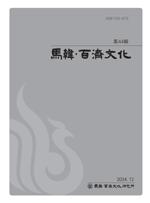- 영문명
- A Study of the Relic Deposits in the Central Foundation Stone of the Asukadera Pagoda and a Comparative Analysis with Baekje Temples
- 발행기관
- 원광대학교 마한백제문화연구소
- 저자명
- 石橋茂登(Ishibashi Shigeto)
- 간행물 정보
- 『마한백제문화』제45집, 52~102쪽, 전체 51쪽
- 주제분류
- 인문학 > 역사학
- 파일형태
- 발행일자
- 2025.06.30
8,920원
구매일시로부터 72시간 이내에 다운로드 가능합니다.
이 학술논문 정보는 (주)교보문고와 각 발행기관 사이에 저작물 이용 계약이 체결된 것으로, 교보문고를 통해 제공되고 있습니다.

국문 초록
Asukadera Temple is considered Japan’s first fully developed Buddhist temple. Construction began in the late 6th century. According to the Nihon Shoki and other historical records, Buddhist relics, monks, and skilled artisans were brought from Baekje in 588 to aid in its construction.
In 1957, the Nara National Research Institute for Cultural Properties excavated the temple’s pagoda site. They uncovered a large central foundation stone (shinso) buried 2.7 meters underground. The Nihon Shoki states that Buddha’s relics were enshrined in this stone on January 15, 593. The following day, the central pillar of the pagoda was erected.
Ancient documents also record that the relics were unearthed in 1197, during the Kenkyū era. Archaeologists found evidence supporting this event. A stone chest at the center of the site contained a 12th-century reliquary. It also held reburied glass beads and ornamental items believed to date back to the temple’s original construction.
Artifacts recovered from the 12th-century backfill include gold, silver, and bronze objects, as well as beads. These are thought to relate to the original relic enshrinement, though their original placements are unknown. In contrast, some items were found in their original positions near the central stone. These include lamellar armor, horse gear, decorative fittings, earrings, and large whetstones. They were likely placed there during the temple’s initial construction.
Recent research and cataloging of artifacts have clarified many details. A copper basin shaped container with lotus petal designs, likely the original reliquary, was confirmed. The Kenkyū-era container held four relic-like pieces, likely made of agate.
A key feature of the site is the mix of Buddhist ritual objects—like gold ornaments and pearls—and grave goods such as weapons and horse tack. This combination is unusual. Most artifacts reflect strong Baekje influence. However, some show links to Gaya and Goguryeo. The relic burial rituals of Baekje and Wa seem to have developed together. Findings at Asukadera will help deepen our understanding of ancient Baekje temples.
영문 초록
飛鳥寺は6世紀末から造営が始められた日本で最初の本格的な仏教寺院である。その造営経 緯は『日本書紀』などに記され、588年に百済から舎利と僧、技術者などがもたらされた。奈 良文化財研究所は1957年に飛鳥寺塔跡を発掘調査し、地下2.7mに据えられた巨大な心礎を検 出した。『日本書紀』には593年の正月15日に飛鳥寺の塔心礎に仏舎利を納め、翌日、刹柱を 建てたことが記されている。しかし飛鳥寺の舎利は建久8年(1197年)に掘り出されたことが 古文書から知られている。発掘調査ではその痕跡も検出した。塔跡中心に埋納されていた石櫃 には12世紀に新作した舎利容器、創建当時のものを再埋納したと思われるガラス玉類や歩揺な どが納められていた。12世紀の埋め戻し土から出土した金銅製品や金銀製品、玉類などはいず れも創建時の舎利埋納儀礼に関係する遺物と考えられるが、本来の位置は不明である。また、 心礎周辺から原位置を保って出土した札甲、馬具類、打出金具、耳環、大型砥石などは創建時 に心柱の周囲に置かれたまま残ったと考えられる。 近年の出土品の整理と調査研究によって、さまざまな遺物の実態が明らかとなった。その結 果、創建時の舎利容器と考えられる、蓮弁を伴う銅鋺形容器の存在が判明した。また、建久 舎利内容器には瑪瑙の可能性が高い舎利らしきものが4粒封入されていることがわかった。飛 鳥寺では金銀製品・真珠など仏教色の強い遺物と、馬具・武具類など古墳副葬品のような物が 混在していることが特徴である。全体的には百済の強い影響が看取されるが、遺物によっては 伽耶や高句麗との関連も指摘される。百済と倭の舎利埋納儀礼は相互に連動しつつ変遷してお り、飛鳥寺の研究成果は百済の古代寺院の理解にも貢献するだろう。
목차
Ⅰ. はじめに
Ⅱ.飛鳥寺の発掘調査
Ⅲ.飛鳥寺の歴史と舎利埋納
Ⅳ.塔心礎埋納品の概要と近年の研究成果
Ⅴ.いくつかの論点
Ⅵ.おわりに
참고문헌
키워드
해당간행물 수록 논문
참고문헌
교보eBook 첫 방문을 환영 합니다!

신규가입 혜택 지급이 완료 되었습니다.
바로 사용 가능한 교보e캐시 1,000원 (유효기간 7일)
지금 바로 교보eBook의 다양한 콘텐츠를 이용해 보세요!




